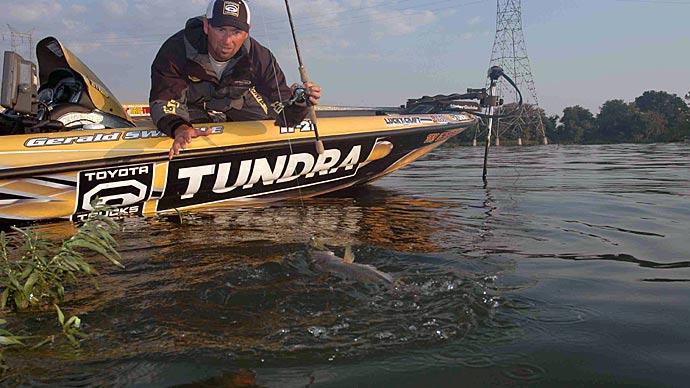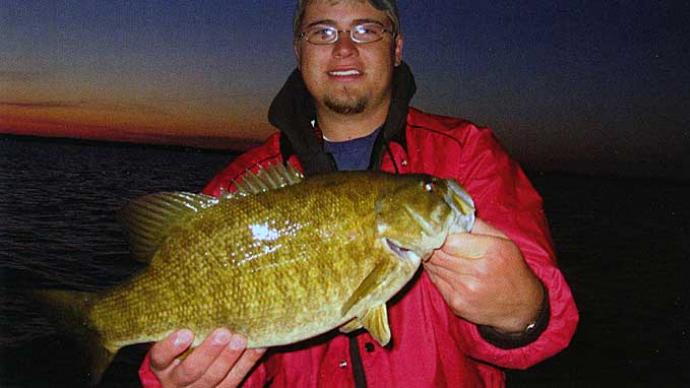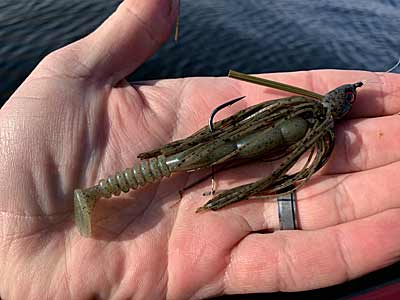
The skirted jig is one lure in bass fishing that has stood the test of time. They have caught fish for decades and will continue for many years. While the basic principle has remained the same, several evolutions of the jig have occurred over the years.
A standard jig features a lead or tungsten jighead, weed guard, and some skirt material made of rubber or silicon. That category of baits includes flipping jigs, football head jigs, and the swim jig: one of the most versatile lures you can use.
What Makes a Swim Jig?
Any jig can be fished through the water with a swimming motion, but specifically designed swim jigs do it better. They generally feature a line tie right at the tip of the jighead instead of further down the jig and are pointed to help make them more weedless.
The swim jig comes in several head sizes, different hook sizes and gauges, and countless different colors. The wide varieties of swim jigs can be grouped into one category and fished similarly.
Fishing a Swim Jig
One of the great things about a swim jig is that it can be cast and retrieved and catch fish. Like everything else in fishing, there are things you can do to trigger more bites.
A standard cast and retrieve will keep your bait in one position, but repeated rod pumps during the retrieve will allow the jig to pulse and rise and fall with each motion. This is a good approach when fishing around submerged vegetation like hydrilla, milfoil, and other grasses.
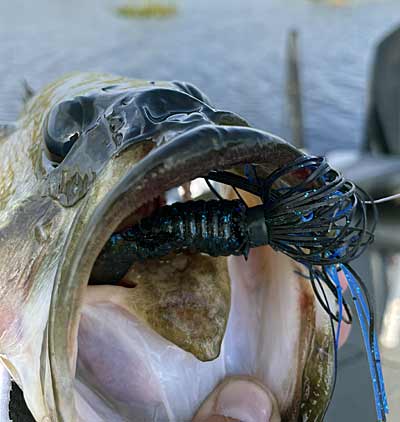
You can fish them around vegetation, wood rocks, docks, and anywhere else bass are located. While you can fish swim jigs everywhere, they excel around scattered vegetation.
In some parts of the country, bass anglers fish swim jigs quickly while twitching the rod. This has become known as the “Alabama Shake,” as Alabama is the epicenter of fishing a swim jig this way. The method allows the bait to quiver up and down during the retrieve quickly and is a great way to trigger bass along shoreline grass and other cover.
Swim Jig Gear
A standard baitcasting rod used for any jig will work great for a swim jig, and rods in the seven-foot range and anywhere between medium-heavy and heavy are the most common choices. A shorter rod works well when making short roll casts to cover or when casting underneath overhanging trees and other objects.
For reels, a baitcast reel with a 7.1:1 gear ratio is a good start and has the right balance of power and speed needed to fish these jigs. The line varies based on the cover as some anglers prefer fluorocarbon and some prefer braided lines.
For the sparse cover, a 15 to 17-pound Seaguar InvizX is a great option, and braided line excels when fishing around thicker cover like grass. A 50-pound Seaguar Smackdown Stealth Gray braided line has enough power to pull fish from the thickest grass.
Color and Size Options
With so many different baits to choose from, picking the right swim jig can seem complicated, but it doesn’t have to be.
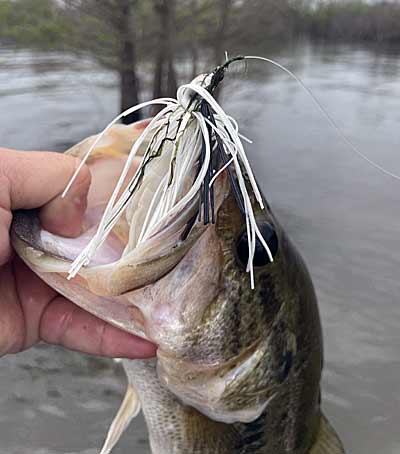
Most swim jigs come in sizes ranging from ¼-ounce to ¾-ounce, but there are some exceptions. Water depth is the most significant factor to consider when choosing the right-sized swim jig for the job. The shallower the water, the lighter the jig as the lighter baits will ride higher in the water column at an average speed. The same is true of heavier baits, as they swim closer to the bottom simply because of the extra weight. Having a handful in different sizes will allow you to match any situation.
There are many to choose from when it comes to colors, and like all jigs, there are some staples. Black and blue excel in dirty water, while green pumpkin offers a more natural look. White is a popular choice and works excellent in muddy water and any time shad are present. There are countless other colors available, and they all have their time and place and will match different forage species and excel under certain conditions.
Swim Jig Trailers
The soft plastic trailer you add to your swim jig will significantly impact how the bait acts under the surface, and there are many different plastics to choose from. The most common options are craw imitations, grubs, swimbaits, and chunk-style plastics. Each has a use and will give it a subtle or more aggressive action.
Crawfish imitators often have flapping craw appendages and wave wildly in the water, while a swimbait will give it more thump. Grubs are between the two and will provide some aggressive movements but add a slight vibration. Chunks are more subtle and will move depending on your action.
Even how you rig your soft plastic trailer can impact the bait's action. For instance, you can rig a standard boot tail swimbait with the tail pointing down or upside down, so the tail is pointed up. The two rigging methods will give the jig a much different action.
Craw imitators can be rigged sideways to make the flapping appendages look more like the side-to-side kicking tail of a baitfish than the waving claws of a crawfish moving up and down. The best advice is to experiment with different trailers and rigging options to get the look you prefer for the situation.
The swim jig is one of the most versatile lures in your arsenal. They work just about everywhere and can be fished in all seasons. Learning to fish a swim jig and gaining confidence in them will undoubtedly lead to you catching more bass this season.
BassResource may receive a portion of revenues if you make a purchase using a link above.


